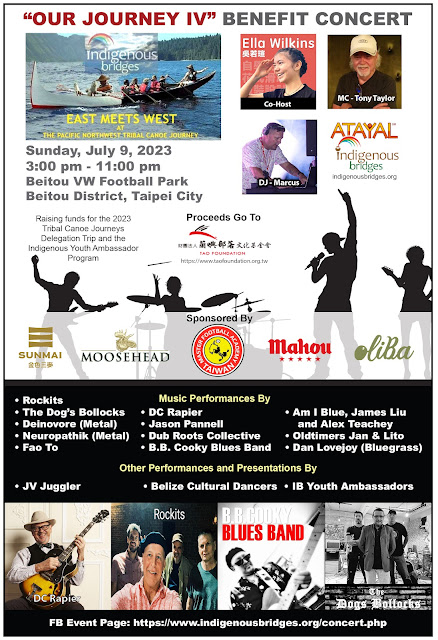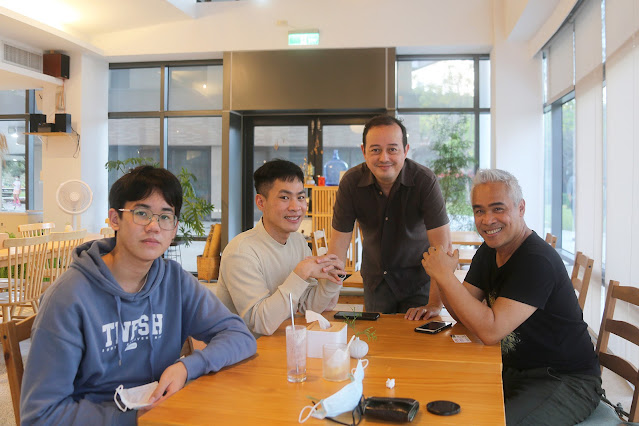A Meeting of Canoes & Cultures at the Museum
Anthonie Tumpag with his former Indonesian Gamelan instructor Pak Ngurah Kertayuda standing behind a gathering of canoes from the Indigenous Taiwanese, Philippines, and Indonesian cultures. Anthonie holds his miniature Tatala canoe pendant next to the Field Museum’s own small scale version of a Tatala from the Tao people.
Earlier this summer, Anthonie Tumpag visited the Field Museum of Chicago where he took a personal behind-the-scenes tour of the museum's small collection of approximately 200 Indigenous Taiwanese artifacts that were collected and donated to the museum over the decades.
Some materials in their collection were Paiwan weapons, Atayal textiles, basketry, jewelry, and also a few pieces from the Tao people such as a clay figurine of a pig and a small scale model of a Tatala canoe.
This is not Anthonie's first opportunity to visit the museum’s vaults and engage with their artifacts tucked away in storage. Since 2013, Anthonie has participated in the Field Museum's co-curation programming with the Filipino community where they engaged with the museum in a collaborative effort to identify and better understand 10,000 objects museum anthropologists had collected since the 1900s.
Jamie Kelly showing visitors the online Philippines Curation Portal
Most recently, the Field Museum has been engaging with members of the Indonesian community for similar purposes in co-curation. According to Jamie Kelly, the Anthropology Collections Manager, the museum cares for approximately 8,000 Indonesian artifacts.
When Anthonie heard the museum was preparing co-curation with the Indonesian community, he quickly reached out to his former Indonesian Gamelan ensemble instructor, Pak Ngurah Kertayuda to see if he, his members and friends of his Indonesian Dance of Illinois group could experience a behind-the-scenes tour as well.
Seeing my former teacher interact with Topeng dance masks was very touching. Pak Ngurah was very excited to see and hold them and out of that encounter came a flood of knowledge. On the spot, he began sharing so much information about the masks, identifying them, reciting songs and even demonstrating some dance gestures tied to each character the mask represented.
Anthonie is amazed and humbled by the accessibility the Field Museum has afforded him and other community members wanting to engage with artifacts from their cultures as well as individuals conducting research.
Several museums across the U.S. have also been opening their own "vaults" in similar fashion. To Anthonie, such accessibility is one way to redress a very complex history of how artifacts have sometimes been acquired in the past and then separated from the peoples and lands they originated.
To Anthonie, accessibility is also one small step towards finding healing in respect to how several western museums once played a role in perpetuating colonialism and the exotification of peoples through the objects they collected and the stories they told in early exhibits and displays. Nowadays, more and more ethnic communities are able to tell their own stories that display their peoples’ cultural objects and heritage.
A wall panel highlighting co-curation at the Field Museum’s Regenstein Halls of the Pacific
With this growing shift towards inclusivity, Anthonie encourages youth to seek out their local museums to find out if there are opportunities to interact with artifacts from their cultures. There’s a lot of knowledge we can learn and appreciate by engaging with such objects especially when you are able to visit alongside an elder who can recount the objects’ meaning and significance for their generation.
In Washington state, other members of ATAYAL also had a similar behind-the-scenes opportunity to visit a museum which Michael Jacobson described with much excitement recently. We “went with Jiun-Yu Liu and Will Tsang and students to the Burke Museum to see part of their Taiwan indigenous collection. Curator Holly Barker and Collections Manager Kathy Dougherty showed us some pieces and then let us walk around the storage stacks.”

















Comments
Post a Comment